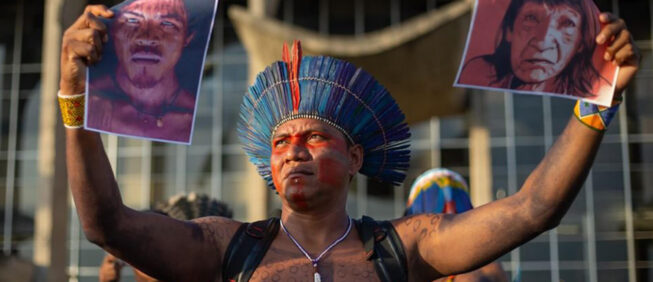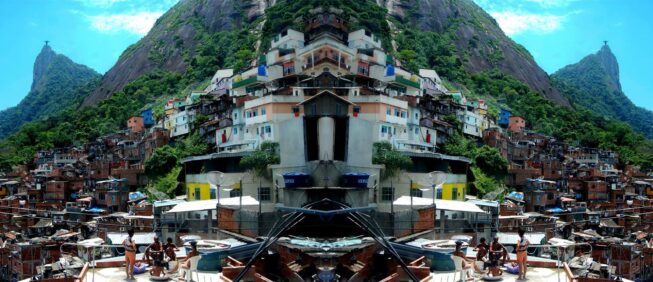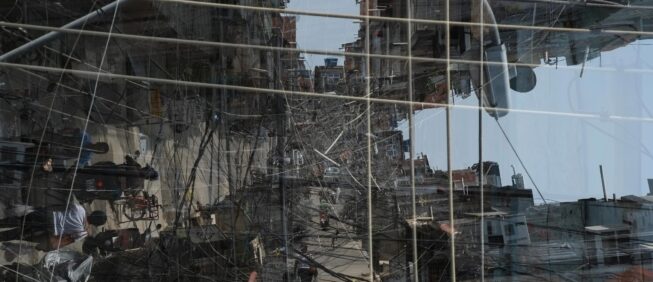If I Manage to Die of Old Age, That’s Fine
End of the World, Race, and Territory in Fradique’s film Ar Condicionado
Luis Felipe Gómez Lomelí
| Mexico | Angola |
translated by Lemuel Robinson
Abstract
Hegemonic societies depend on the performance of control over the environment to actually exert control over racialized and subalternized bodies in a given territory. This performance requires both a discourse and a particular territorialization to separate positive and negative externalities from each other, but it crumbles when a catastrophe, real or imagined, is identified. Then, the intertwined assemblages of territories, and of different actors’ hidden agendas, are revealed. This article examines that unveiling process,which echoes the staged discourses on climate change in the 2020 Angolan film Ar condicionado, by Fradique, in which an imaginary pandemic desolates the country: the widespread failure of air conditioning machines.
Keywords: Anthropocene, air conditioning, Angola, ecocriticism, Fradique, health, race, territorialization.
Dying of old age, dying after the average human life expectancy, is the privilege of a small group. Dying after the average life expectancy of people in the most privileged neighborhoods of the richest countries is an illusion. According to the WHO, in 2016 the world’s average life expectancy was 72 years, and, for Africa, 61.2.1 https://www.who.int/gho/mortality_burden_disease/life_tables/situation_trends_text/en/. But in the US, in Boston, the life expectancy in Back Bay — a predominantly white neighborhood — was 90 years, and in Roxbury — with over 90% of its population racialized according to US census classifications2U.S. Census Bureau, “American Community Survey, 2007-2011Estimate: Roxbury”, accessed October 20, 2020 https//bostonplans.org/getattchment/60eb2dc7-61dc-4edc-b608-effba2ec54d0/ — was less than 59.3 Galea, “Health and the City,” accessed June 10, 2020 Roxbury is, in such terms, further from its own city neighbors than the citizens of the Central African Republic: the country with the lowest average life expectancy in the world, at 53.3 years. Five years4 https://ourworldindata.org/life-expectancy. of difference means sharing the same future. More than 30 is to live in different worlds. And in this world, there are more than 1.4 billion human beings suffering from chronic hunger.5 See Caparrós, Martín, Hunger: The oldest problem, Brooklyn y Londres, Melville House, 2020, p. 351.
The health-race-territory trifecta is inseparable. Not for ontological reasons, but because of a system where externalities, economic as well as environmental, are limited to specific places and embodied by set populations. The epitome of this territorial disparity appeared in 1945 with the proliferation of ethno-specific consumption of air conditioning units: a micro-territorialization of positive externalities (i.e. the cool air of an apartment) and the widespread increase in negative externalities (i.e. the effects of greenhouse gases).
The current hegemonic discourse regarding the anthropocene comes not only from loci of privileged declarations, validating itself through a process of social inbreeding, but it also acts as speech act, constructing “universal realities” that later are replicated by members of subaltern societies.6 The term “speech act” comes from performance theory. See Richard, Performance Studies: An Introduction, London and New York, Routledge, 2013. It is also used in reference to the anthropocene from the perspective of racialized bodies. See Yusoff, Kathryn, A Billion Black Anthropocenes or None, Minneapolis, University of Minnesota Press, 2018. For the concepts of “resistance,” “hidden transcript,” and “public transcript,” see Scott, James C., Domination and the Arts of Resistance: Hidden Transcripts, New Haven, Yale University Press, 1990. On “assimilado,” see Cabral, Amílcar, “Libertação nacional e cultura,” en Cultura em tempos de libertação nacional e revolução social: Amílcar Cabral, Samora Machel e Mário de Andrade, org. Marco Mondaini, Recife, Editora UFPE, 2016. For the concept of “cool,” see Hind, Emily, Dude Lit: Mexican Men Writing and Performing Competence, 1955-2012, Tucson, The University of Arizona Press, 2019, pp. 146-180. So what do we speak of when we say “the end of the world”? How are territories parceled out in institutional discourse? How does resistance from racialized bodies on one hand, and the cohabitation of the assimilado cool on the other hand, manifest in this scenario? Ar condicionado (2020), an Angolan film released online in the fourth month of the Covid-19 pandemic, offers some answers. There Matacedo declares: “If I manage to die of old age, that’s fine.”7Ar condicionado, directed by Fradique, produced by Geração 80, 2020. Streamed online via the YouTube We Are One: A Global Film Festival, between June 6 and June 16, 2020: youtube.com/cannel/UChMc3c7Xvv6ol1Zv47Ja39A. Todas las traducciones son propias salvo que se afirme lo contrario.
Like something localized, war or hunger, the end of the world means something distinct for the minority from that of the vast majority: privileged people are the first to leave when a timely “end of the world” occurs. Better still, they were never even there, as in the case of extractivist projects or in the provision of airports, landfills, etc… what is known as environmental racism in ecologist slang.8 For more on the classification and explanation of the different ecologist movements, including environmental racism, see Merchant, Carolyn, Radical Ecology: The Search for a Livable World, Nueva York, Routledge, 1992. That’s why hegemonic discourse on climate change speaks of an apocalyptic end of the world, so that it’s a problem for humanity. Chakrabarty says: “there are no lifeboats here for the rich and the privileged... witness the drought in Australia or recent fires in the wealthy neighbourhoods in California.”9 Chakrabarty, Dipesh, “The Climate of History: Four Theses”, Critical inquiry, Vol. 35, No. 2, 2009, p. 219.
Surely, if there is a global cataclysm, like the meteorite that crashed into Chicxulub, there will be no lifeboats (thinking of it like the movie Titanic is meaningful), but before that happens, the idea of the end of the world has to do less with a cataclysm and more with, as Siskind mentions, the dependence on a supposedly stable notion of “world” [with] the world understood as the symbolic structure that used to sustain humanistic imaginaries of universal emancipation, equality, and justice.”10 Siskind, Mariano, "Towards a cosmopolitanism of loss: an essay about the end of the world." en Siskind. World Literature, Cosmopolitanism, Globality, Eds. Müller, Gesine y Mariano, Vol. 4., Berlín y Boston, Walter de Gruyter GmbH, 2019, p. 206.
That stable notion of “world,” that symbolic structure that sustains itself through the exploitation of nature and the bodies of subaltern persons (relegated to the category of “inhuman,” as Yusoff points out), and that in turn sustains supposed supposedly humanist imaginaries, (“the mansion of modern freedoms stands on an ever-expanding base of fossil-fuel use,” says Chakrabarty without irony) is that which can end for the privileged minority. This is the end of its world.
The importance of tackling this distinction resides in the fact that most of the devastation of the planet is caused not by “humanity” but by privileged minorities.11There is a wide range of work on the differences in levels of consumption and ecological footprints across different sectors of society. For an analysis from the perspective of economy and ecology, see Martínez Alier, Joan, El ecologismo de los pobres, Barcelona, Icaria Antrazyt-FLACSO, 2004. For a quick look, wikipedia is informative: https://en.wikipedia.org/wiki/Ecological_footprint. For a closer look, including content on the pandemic and the relationship between environmental devastation, territory, and health, see Vidal, John, “Destroyed Habitat Creates the Perfect Conditions for Coronavirus to Emerge”, Scientific American, acceso 22 mayo 2020, https://www.scientificamerican.com/article/destroyed-habitat-creates-the-perfect-conditions-for-coronavirus-to-emerge/ And these are the ones who establish performance parameters and articulate a public discourse that incites fear. These minorities are the ones that play the double card of macho cool: those that were "barbarians” now present themselves as “civilized.”12On the term “performance,” see Shechner, Performance Studies, 123. For its environmental analogue, see the work Latour, Bruno, Ciência em ação: como seguir cientistas e engenheiros sociedade fora, São Paulo, UNESP, 2000. The former is clear for Chakrabarty: “Climate change is an unintended consequence of human actions and shows, only through scientific analysis, the effects of our actions as a species… It calls for a global approach.”
This is a saccharine perspective (“unexpected consequence”), spreading blame (“the effects of our actions as a species”), hierarchy (“we only realized it through scientific analysis”), and spreading responsibilities (“global action is necessary”), but how much do you seek to save humanity or how much do you seek to maintain the stability of the "world" for a minority? Further, given that this discourse influences the performance of majorities and the assimilated — in the two versions of Amilcar Cabral: those who desire to be like the boss and those who take the tools of the oppressor to subvert the system — what are the margins of possible resistance?13 I will use Cabral’s term in Portuguese in order to highlight its difference with the colloquial usage of the word assimilado in Spanish. See Cabral, “Libertação nacional e cultura”, 76. This is an important term, because it signals the differences with two other versions of assimilado, that of the Mexican “malinchista” line and Ngūgī’s “purchaser” concept, both of which refer only to those who yearn to be like their patrón. See Ngūgī wa Thiong’o, Decolonising the Mind: The Politics of Language in African Literature, Oxford y Nairobi, James Curry Heinemann, 1986.
These questions are implicitly considered in Ar condicionado (2020), the feature-length film directed by Mario Bastos, also known as Fradique, to address a created, recent necessity, that of air conditioning. The heating/cooling (HVAC) systems define an atmospheric territorialization that can be as tiny as an apartment or as immense as a mall. It can also be imagined as a web of nodules — by university, by neighborhood, by country — with two populations differentiated by design, with segregated to minimize thermodynamic exchange: those who are inside (globally privileged minorities) and those who are outside. The “necessity” of ACs is also the leading cause of domestic electricity consumption in the world.14 Figures vary from society to society, but peaks in consumption of domestic electricity in societies accustomed to the generalized use of air conditioning and heating systems (that is, rich societies) consistently coincide with the hottest and coldest months of the year. On Japan, for example, see Honjo, Keita et al. “Dynamic linear modeling of monthly electricity demand in Japan: Time variation of electricity conservation effect,” PloS one, vol. 13, no. 4, 2018. And the generation of electricity is one of the industries that contributes to the production of greenhouse gases.15 See IPCC and IGBP documents at www.ipcc.ch and www.igbp.net So, what would happen if a “pandemic” were to blow up, causing these units to fall from the windows throughout an entire country?
Thus begins Ar condicionado. After the opening credits, “air” is defined (1.Fluid enveloping the Earth… 5. Appearance, look. 6 Quality), as is “to condition” (1. To become dependent on condition. 2. To place conditions. 3. To condition.) and, lastly, air conditioning as a system. Entries 5 and 6 for “air,” combined with those for “to condition,” allow for a rereading of the definition of the system from the recursive dependence that carries with it the eagerness for imposing conditions, or controlling nature, and a need to create the appearance of said control to maintain an “air” or a form of determined behavior within a certain group of people.
After the definitions, against a black background, the off-screen voice of a radio commentator indicates that it’s 7 AM and we later see, close-up, Zézinha seated in public transportation without AC while the voice off-screen talks about “the increase in deaths caused by the heat” across the country and the falling of air conditioners, saying that the Angolan Association of Refrigeration, Air Conditioning, Heating, and Ventilation has called for the government to resolve “this mystery,” and that a Chinese conspiracy to sell fans was suspected. Zézinha then arrives at her destination, near the corner of Rua Major Kanhangulo and Calçada Comandante Veneno, near Calle Rainha Ginga — or Rainha Njinga — where almost all of the movie was filmed.16You can find the streets used for the set on Google Maps, Google Earth, and other digital map platforms
We are in downtown Luanda, just steps from the Ministry of Foreign Relations and the Agostinho Neto Foundation. It is a changing, well-to-do area, a testament to both the Portuguese architecture of Old Luanda and the New Luanda erected by metal cranes. We follow Zézinha’s steps in a sequence shot that starts when the door to the van opens, and ends with her in front of a building full of ACs. The off-screen voice confirms that yesterday’s tally consists of “one person dead, three injured, and a parked Lexus...” that were affected. All due to the falling AC units. Cut to Zézinha and Matacedo, the security guard at the building she works in, drinking tea in the laundry room. Zézinha talks about the “real air,” the wind from the sea that reminds her of her father, when her cell phone rings and you hear the irritated voice of her boss asking why the AC still isn’t working. She hangs up. She asks Matacedo if he has already gone to the home of Dona Ana to offer his condolences at the wake. He says no, and she urges him to go.
In less than 8 minutes, the two pillars of satire and point of view are already clear. We begin by rethinking the meaning of “air conditioning” as framed in efforts to maintain control and appearance. We move from a presentation of hegemonic discourse — raising the subject as one that should matter to us all — to a focus on a specific group and the invisibilization of the victims of bodily harm, nameless even as the brand of luxury car that was damaged is emphasized. The shot centers on Zézinha, who has worked as a domestic employee since she was fired, and on Matacedo, an older man who still suffers from poor hearing from an accident during the war (sometimes he can’t hear or sleep), who wears a uniform but no weapons, and also does home repairs and carries residents’ grocery bags. We will follow them both as they try to fulfill the order from Dr. Nok, whose air conditioner hasn’t fallen from the building (yet), but has stopped working, so he’s ordered it be repaired.
The movie doesn’t limit itself to the luxuries and the suffering of the upper class for having lost its air conditioners, its end of the world. Rather let’s attend to the perspectives of Matacedo and Zézinha, to their spaces — the street, the storage room, the patio where the AC generators are — we see them living their day-to-day, especially Matacedo — bathing, chatting, YENDO with another domestic employee who saves him food from what is left by their bosses, food that Matacedo shares with his friends while they play checkers on the pavement. It’s not the everyday nature that the boss imagines — and that is depicted in countless films that romanticize servitude, from Gone with the Wind (1939) by Victor Fleming to Roma (2018) by Alfonso Cuarón — one of work without rest. Instead, the film shows this “hidden agenda” that always accompanies the public discourse: strategies of resistance through little lies, through disappearing from the monitoring gaze to play with friends.
The privileged class is described with the same economic narrative: Dr. Nok arrives and asks, “This shit isn’t ready yet?” Zézinha and Matacedo begin to respond, but he interrupts them saying, “I don’t want to know if everything is falling or not. Mine isn’t going down… I’m in charge here. Is that clear?” The ideology and the performance remain clear: it’s a man with power, obsessed with exercising control over the animate and inanimate environment, an individualist for whom it doesn’t matter what happens to the rest of the world because he has the illusion that “there,” in his world, he’s in charge. From Hind’s perspective, he is a cool guy, so not only is he capable of speaking nonsense, he’s capable of affirming nonsense without losing the civilizing status of his title: he’s a “doctor.” From Cabral’s framework, Dr. Nok represents this assimilado elite that has adopted the ways and needs of the global elite: he has to continue having an air conditioner despite the fact that all of them are falling to pieces and global warming rages on.
The panic of the comfortable classes is referred to only by the voices of the radio and television. These voices say that the first steps to fix the problem are to “have the government resign,” to disassemble and replace all the ACs and create “a social policy that is aligned with the climate conditions of our country,” and that they’re done importing “foreign models.” They insist that even though we are in “the coldest time of the year,” the number of deaths keeps increasing. All the deaths are nameless, no one has died of heat, but the “country’s 18 provinces are on alert” and a commission of 20 specialists has been created to investigate the failure of the “air conditioners and to control the heat wave.” Another woman’s voice on the radio says, “good afternoon, neighbor, what is it that you are doing seated in front of my door?” The neighbor is there, catching the cool air escaping from the cracks in the door frame because her place is “an oven.” We then find out that it’s not a spontaneous dialogue but a commercial: “Say goodbye to heat in your home.”
The voices on the radio and television thus highlight the ideology and the performance of the privileged classes as expressed in the character of Dr. Nok: 1) the catastrophe of the few becomes a national alert despite the fact that environmental conditions are at their the most favorable point of the year, the Angolan dry season, 2) if the government can’t maintain the stability of the privileged classes, then they must be made to resign, 3) those excluded from the air conditioned micro-territories are made to look ridiculous, and 4) the protest discourse is appropriated, used as a platform for rejecting foreign models and affirming that the “heat wave” will be controlled through social policies.
Matacedo and Zézinha move through territories without AC where no one appears to be dying from the heat. It is then that we begin to attend to the incredulity of the majority before the panic of the rich, “in this promised land [where] all the sinners are saints.”17This is sung by a man on the rooftop of the building behind theirs. Behind him we see the crains building the new Luanda This downturn is accentuated when Matacedo and Zézinha pick up Dr. Nok’s air conditioning at the workshop of Cota18 Buddy or pal in Angolan Portuguese Mino, an electrician that extracts human memories from AC capacitors and records them on videocassettes. “Our memories are in here,” says Matacedo. But, seeing images of privileged people eating meat, Zezinha responds, “Our memories how? Our neighborhood doesn’t have air conditioning.” Cota Mino explains that before, our memories fell from the trees, like fruit, but that now only air conditioners fall: that’s why only these are here.
The fantastical turn continues for a few minutes until Cota Mino explains that he has built a machine to guarantee that “none of our memories will be left out.” In a room is the carcass of a military jeep without a motor, with cables and plants everywhere — “the last of the city,” he asserts. and then concludes: if something goes badly, we have plants. The national hymn of Angola plays and the jeep’s air conditioner turns on. But it works only for an moment, right when Matacedo finally manages to finally sleep and remember and see and hear other moments of the city, and the music says “I dream to not forget,” until Zézinha wakes him because this is crazy and stupid, and they put the boss’s AC in a shopping cart and leave, but not before Cota Mino gives, like a treasure, a casuarina seed to Matacedo.
Here, the meaning of assimilado is shown in the character of Cota Mino, who uses the tools of the hegemonic structure to try revertir it and construct a machine that contains all of our memories, the memories before ecocide, not just those of the privileged classes that drove ecocide and used it as a means of exploitation. Also, through Zézinha’s questioning, as with the suspension of the magical plot twist, the film highlights the practice of appropriation undertaken by hegemonic discourse: the future of the upper classes is your future; the anthropocene is everyone’s fault. And, likewise, it invites us to embrace the petition that Kathryn Yusoff makes in the title of her book, A Billion Black Anthropocenes or None: the story of the world, understanding “history” as “environmental history,” cannot be reduced to the ecocidal minority.
But when the film seems to take the grave turn of social criticism of the upper classes, when Zézinha finally convinces Matacedo to go to Dona Ana’s home for the wake and he says that Dona Ana’s pain is his pain, that he knows what she has lost — unlike the people from the rich neighborhoods — and Zézinha emphasizes that they should not go because of “that cold body” but that “we go for us, for our sake,” it is then that we witness one of the film’s final satiric twists: the wake is for an AC unit that has stopped working, and there are photos of the device in small altars with lit candles and three woman are crying before the appliance’s “casket.” Matacedo doesn’t cry or get upset.
In this way, Ar condicionado not only problematizes — and satirizes — the idea of the end of the world for the privileged minority through the incredulous sight of the majority for whom this created need — the air conditioner — is an illusion, it also establishes how that need is also the desire of millions of people. Having an AC, as a metaphor for being part of the elite and adopting its ways, is precisely the fear that Cabral felt before the danger that national liberation movements would be coopted by an assimilated minority: that history would repeat itself when there are no other stories told.
For minorities, represented by Dr. Nok, this end of the world implies the loss of a way of life (of a humanist archetype?) and the unease caused by the possibility of losing control of their surroundings, including human beings and non-humans: “I’m in charge here.” Said fear directly influences the progressive and positivist speech that we find in debates on global warming: the best environmental schemes have to come from the ethospecific group of privileged countries and, more particularly, from certain artificially climatized microterritorites: universities, corporate offices… A speech that, like Dr. Nok, can use contradictory terms like “sustainable development,” because it’s easier to express nonsense and continue being cool than to accept that the hegemonic idea of “development” brings with it the very problem that we seek to confront. 19This fear, as much of losing control of the discourse as of losing the way of life to which one is accustomed and having to do that which the immense majority of people do (washing dishes, for example), has been evident in coverage of the Covid-19 pandemic in ethno-specifically privileged media. See, for example, the following headlines in Wittenberg-Cox, Aviva, “What Do Countries with the Best Coronavirus Responses Have in Common? Women Leaders,” accessed June 10, 2020, https://www.forbes.com/sites/avivahwittenbergcox/2020/04/13/what-do-countries-with-the-best-coronavirus-reponses-have-in-common-women-leaders/#12c5c9b13dec, or Bremmer, Ian, “The Best Responses to COVID-19 Pandemic,” accessed June 14, 2020 https://time.com/5851633/best-global-responses-covid-19/ or Carras, Christi, “Cómo los ricos y famosos están lidiando con la pandemia de Coronavirus,” accessed June 14, 2020 https://www.latimes.com/espanol/entretenimiento/articulo/2020-03-15/como-los-ricos-y-famosos-estan-lidiando-con-la-pandemia-de-coronavirus
The fraternity of the privileged minority masks itself by means of rhetoric: its problem presents itself as something that concerns us all and affects us all equally. As speech act, the mediatic and institutional discourse establishes the existence of the problem like “those dead from the heat wave.” The heat wave exists, thus, even though it’s the coldest time of the year and the deaths are unrelated. So, establishing who the victims are and who lack names implies that those without ACs are not part of the world that matters or of the race that matters, and don’t deserve the attention of the institutions. Worse: they should feel privileged and sacrifice themselves to fix the problems of the patrón.
But for the others — those who only access the benefits of AC in their place of work, sticking to the neighbor’s door, or like Dona Ana, saving for years — this end of the world is the end of the future, of the dreams of economic progress that can be made out in the towers that make up “New Luanda.” Before the disaster of an impossible future, Cota Mino keeps in the file of memories and of plants. Zézinha on the withdrawal: “My greatest fear was dying drowned in my own dreams.” And Matacedo in a simple hope: “If I at least manage to die of old age, that’s fine.
Dying of old age is the antithesis of the end of the world. Not at the 90 years of Back Bay in Boston, not even at the 72 years of age that is the world average. Dying of old age is a privilege unknown to the 1.4 billion people that lack even the bare minimum to eat, to the residents of Roxbury, in Boston, something unknown to the so-called essential workers, and unknown to the inhabitants of all the places in the world where extractivist economics installs itself, sending its benefits elsewhere, to developed cities. Dying of old age is a privilege of a cool minority — the same minority that Caparrós accuses of using “humanity as a tool of guilt, to send bags of grain, not to deprive themselves of earning a lot of money, not to seek a real end to the problem.” 20 Caparrós, Hunger, p. 363. Free translation of Lomelí’s Spanish rendering
In the best of cases, as Ramón López Castro said, for the immense racialized majority of the world, “the end of the world is always the present.”21 Ramón López Castro, private video-conference at the Science Fiction Roundtable, May 22, 2020 Or, worse, the end of the world already passed by our territories, and we have lived and have already been born into a post-apocalyptic world.
CABRAL, Amílcar. "Libertação nacional e cultura." In Cultura em tempos de libertação nacional e revolução social: Amílcar Cabral, Samora Machel e Mário de Andrade, Org. Marco Mondani. Recife: Editora UFPE, 2026, pp. 33-58.
CAPARRÓS, Martín. Hunger: The oldest problem. and London: Melville House, 2020, pp. 351-363.
CHAKRABARTY, Dipesh. "The climate of history: Four theses." Critical inquiry, vol. 35, n. 2, 2020, pp. 197-222.
FRADIQUE and Ery CLAVER. Ar Condicionado. Film. Directed by Fradique. Produced by Geração 80, 2020.
GALEA, Sandro. "Health and the city." Boston University School of Public Health. March 8 2020. Accessed May 15 2020. http://www.bu.edu/sph/2015/03/08/health-and-the-city/.
HIND, Emily. Dude Lit: Mexican Men Writing and Performing Competence, 1955-2012. Tucson: The University of Arizona Press, 2019, pp. 146-180.
LÓPEZ CASTRO, Ramón, private video-conference for the Science Fiction Roundtable with Luis Felipe Gómez Lomelí. May 22, 2020.
SCHECHNER, Richard. Performance Studies: An Introduction. London and New York: Routledge, 2013, pp. 132-169.
SCOTT, James C. Domination and the Arts of Resistance: Hidden Transcripts. New Haven: Yale University Press, 1990, pp. 1-69.
SISKIND, Mariano. Towards a cosmopolitanism of loss: an essay about the end of the world. Vol. 4, in World Literature, Cosmopolitanism, Globality, by Gesine Müller and Mariano (Eds.) Siskind. Berlín y Boston: Walter de Gruyter GmbH, 2019, pp. 205-206.
YUSOFF, Kathryn. A Billion Black Anthropocenes or None. Minneapolis: University of Minnesota Press, 2018, pp. 1-65.

Luis Felipe Gómez Lomelí | Mexico |
Luis Felipe Gómez Lomelí holds a PhD in the philosophy of science and is a PhD candidate in literature at the University of Kansas Department of Spanish and Portuguese in Lawrence, Kansas.
lomeli@ku.edu






